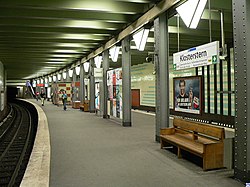The construction of such a railway had long been discussed, meanwhile an elevated train was also considered. In 1906 a circular route was begun, connecting Hamburg Hauptbahnhof – Berliner Tor – Barmbek (earlier spelling: Barmbeck) – Kellinghusenstraße – Schlump – Landungsbrücken (earlier designation: Hafentor) – Rathaus – Hauptbahnhof with branches to the quarters of Eimsbüttel, Ohlsdorf and Rothenburgsort. On 15 February 1912 the first stretch of the future Ringbahn (Circle railway) between Rathaus station and Barmbek was inaugurated. The stretch included both underground and elevated sections.
Network development
By 1915 the Ringbahn and the three spurs, from Kellinghusenstraße to Ohlsdorf, from Schlump to Hellkamp (today: disused station between Oster- and Lutterothstraße) and from central station to Rothenburgsort were completed. By 1934 the extensions from Ohlsdorf to Ochsenzoll ( Langenhorner Bahn), from Kellinghusenstraße to Jungfernstieg (KellJung line), and the Walddörferbahn (Forestvillages line) from Barmbek to Großhansdorf and Ohlstedt were completed.
In 1943, during the Second World War the subway was badly damaged during 'Operation Gomorrha,' the RAF bombing of Hamburg that summer. The stretch from Hauptbahnhof to Rothenburgsort was not repaired because the district it passed through had been completely destroyed. [7] It was five more years before the remaining network was once more completely intact.
Further additions to the network were made, starting in 1960. The KellJung line was extended via Meßberg to the central station (Hauptbahnhof). Later in 1962 the extension reached Wandsbek Markt and in 1963 Wandsbek-Gartenstadt. The total network length was 67.9 kilometres (42 mi).
The construction of a Durchmesserstrecke (diameter route) began in 1963. The plan was to connect Billstedt with Stellingen. The Eimsbüttel branch formed the western part of the line. The branch was extended up to Hagenbecks Tierpark in 1966. The existing terminus at Hellkamp was withdrawn from service in 1964 and a new station was built at Lutterothstraße further northwest.
The connection between Berliner Tor and Horner Rennbahn was opened in 1967. In the same year this eastern branch was extended to Legienstraße. Further extensions took place in 1969 to Billstedt and in 1970 towards Merkenstraße. The extension Ochsenzoll – Garstedt came into service in May 1969. Thus, the network total length reached 88.5 km (55 mi).
A new core stretch of the line U2 , between Schlump and Berliner Tor, became a direct connection through the city centre. Next to be brought into service were sections from Hauptbahnhof Nord to Berliner Tor in 1968, and from Schlump (low) to Gänsemarkt in 1970, then the last section, with two new platforms on the lowest level at the station Jungfernstieg under the Binnenalster, in 1973. This station, as well as Hauptbahnhof Nord, was developed as part of the U4 line that was planned at that time.
In 1985 the section to Hagenbecks Tierpark was extended to Niendorf Markt and again in 1991 as far as Niendorf Nord . In 1990 the extension Merkenstraße – Mümmelmannsberg was opened. The line extension opened in 1996 between Garstedt and Norderstedt Mitte , which replaced the southern part of the Alsternordbahn.
In 2005 the Hamburg U-Bahn had a length of some 100.7 kilometres (63 mi), of which 40 km (25 mi) are underground. It had 89 station stops.
In 2009, the U3, beginning in Barmbek, traversed the complete ring line, thereby taking over the stretch between Berliner Tor and Barmbek, which was formerly served by the U2. In order to realise a problem-free service, a redesign of the current track layout to the west of Berliner Tor was necessary. An originally planned grade separated crossing of the two lines was realised, which was left undone before due to cost. Trains coming from the city centre leave the ring at Barmbek and continue via the viaduct stretch to Wandsbek Gartenstadt. One branch leads via the Walddörferbahn to Wandsbek-Gartenstadt, a stretch formerly served by the U2. [8]
In 2012, the U4 started operations between Billstedt and HafenCity University, sharing most of its route with the U2 and thereby increasing service on the highly used line between Berliner Tor and Billstedt. The U4 was extended further east to Elbbrücken in December 2018, providing a future S-Bahn connection. [9] [10]

































